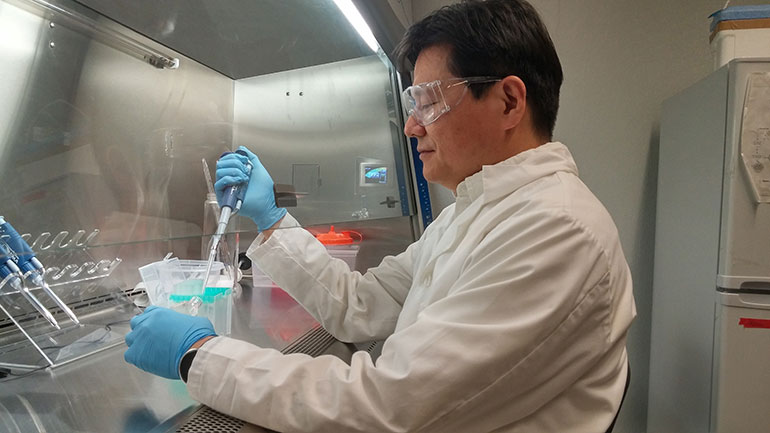
UBC assistant professor Keekyoung Kim in his lab.
From $100,000 to $100, UBC Okanagan engineer makes microscopic imaging accessible
For slightly more than $100, a researcher at UBC’s Okanagan campus has created a compact, portable and high-performance microscope that enables wireless real-time imaging.
It’s the perfect tool for biomedical engineering research, says Keekyoung Kim, an assistant professor of engineering.
Kim’s research group was looking for a way to monitor live cells and microsystem devices over an extended period of time. Such microscope systems exist but cost in excess of $100,000, making them inaccessible for many researchers. Kim says his team was inspired by today’s rapidly-changing technology.
“We looked at other mini-microscope systems using smartphones and webcams, and thought if we can incorporate the electronics of a security camera, we might be able to build one ourselves with the capability of wireless monitoring,” says Kim.
His group paired an inexpensive embedded circuit board called a Raspberry Pi—a single-board computer about the size of a credit card—with a five-megapixel camera and a USB Wi-Fi adapter. The system is able to capture and transmit pictures and videos for upwards of 50 continuous hours and can be used in remote places when there is no electricity.
“While there are many DIY smartphone-based mini-microscopes, they are difficult to use in many laboratory or field conditions and cannot be used for longer than 24 hours,” says Kim. “What makes our microscope novel is that we can do continuous wireless monitoring and storing of videos for more than two full days with a high frame rate and at high quality.”
With the benefit from high-quality images, the post-image processing is able to automatically analyze the data they collect to determine useful information, such as the coverage rate of cells and the generation frequency, diameter, and thread length of droplets.
“Successful applications demonstrate that the mini-microscope system has a great potential in many biological and biomedical applications,” he adds. “We certainly see the demand for more portable and affordable systems.”
The wireless mini microscope system can shoot with a high resolution at 90-frames per second. Kim says it is already making an impact on the work being done at the Integrated Bio-Micro/Nanotechnology Laboratory at the Okanagan campus.
The paper outlining the mini-microscope system was published in the IEEE Transactions on Biomedical Engineering. The research was supported by a Natural Sciences and Engineering Research Council of Canada grant.
About UBC's Okanagan campus
UBC’s Okanagan campus is an innovative hub for research and learning in the heart of British Columbia’s stunning Okanagan Valley. Ranked among the top 20 public universities in the world, UBC is home to bold thinking and discoveries that make a difference. Established in 2005, the Okanagan campus combines a globally recognized UBC education with a tight-knit and entrepreneurial community that welcomes students and faculty from around the world. For more visit ok.ubc.ca.
 BC boosts milk production
BC boosts milk production Baby lives after stroller hit
Baby lives after stroller hit U.S. authorities find body
U.S. authorities find body UN workers charged
UN workers charged  Trudeau in Saskatoon
Trudeau in Saskatoon  Doctors protest tax change
Doctors protest tax change $620 million for Ukraine
$620 million for Ukraine  5 die crossing channel
5 die crossing channel Jury finds railway at fault
Jury finds railway at fault  Tourism operators struggle
Tourism operators struggle  Nude Beverages sells line
Nude Beverages sells line Wealth gap widening
Wealth gap widening Leafs even series
Leafs even series Cristall gets pro look
Cristall gets pro look Warriors even series in OT
Warriors even series in OT Hozier surprised by #1
Hozier surprised by #1 Trainor to replace Perry?
Trainor to replace Perry? Swift breaks Spotify record
Swift breaks Spotify record



